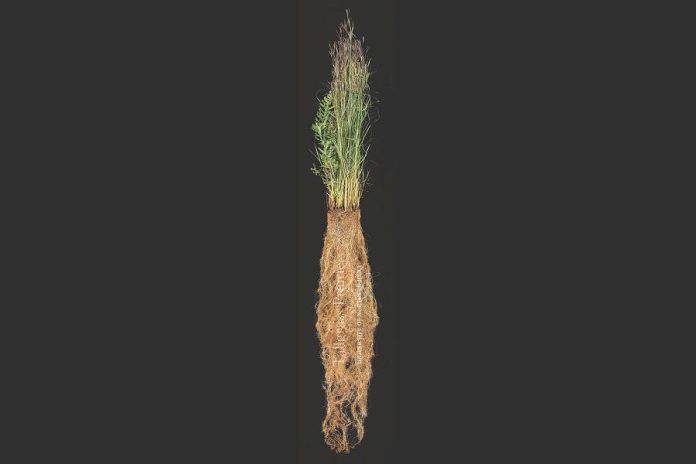
In the garden at this time of year, you may notice the purple blooms of coneflowers, the stunning red spikes of wild bergamot flowers, the fragrance of a peony, or the pop of white on yarrow. Plants provide beautiful colour, texture, improved air quality, and food for pollinators.
What I love most about the gardens I see around Peterborough is what you can’t see, what lies beneath the blooms and stems: the roots.
The main function of the roots of a plant is to absorb water and nutrients from the soil and move them into the stem. The stem then distributes water and nutrients to the leaves.
Roots do two remarkable things to help us water in the garden. First, roots will seek any pockets of water beneath the soil — especially during times of drought — to help keep a plant thriving. Second, during heavy rainfall periods, rain is absorbed into the soil and follows the deep roots further down into the ground to replenish groundwater.
The plants you choose matter when you are designing a garden that will help capture rain or tolerate droughts.
These choices are often not about the colour of the plant, the height, or the cost. These choices are about what you can’t see: how deep roots will grow.

“Many of the plants that are well suited to rain gardens and water-wise landscapes are those with substantial root systems,” explains Hayley Goodchild, coordinator with GreenUP’s NeighbourHOOD programs. Goodchild is also supporting the City of Peterborough’s Rain Garden Subsidy Program, providing one-on-one consultations to help with garden design and plant selection.
“Some of these plants, like switchgrass, grow deep roots that can reach water many feet below the surface,” she adds. “Others, such as wild geranium, develop shallow but dense rhizomes and fibrous roots that hold lots of water.”
Plants like these have the potential to help us face a number of climate change challenges. Communities and organizations, including GreenUP, have been advocating for and demonstrating these nature-based solutions, often called green infrastructure.
The Ontario Green Infrastructure Coalition explains that green infrastructure is the natural vegetative systems and green technologies that collectively provide society with a multitude of economic, environmental, and social benefits. Green infrastructure can include rain gardens, wetlands, parks, rain barrels, green roofs, and bioswales — channels designed to concentrate stormwater runoff while removing debris and pollution.
What makes green infrastructure effective? Green canopies and planted spaces, like gardens, can cool local waterways (helping our aquatic friends) and parks, sidewalks, and trails (aiding our human health). Other kinds of green infrastructure, like green roofs or walls or shade provided by trees, also support more efficient home and business energy systems.
In addition to these important benefits, green infrastructure is increasingly popular because of all those roots and the water management solutions they provide.

“By growing healthy, robust roots these plants can withstand long periods without rain,” explains Goodchild. “When it does rain, these plants are effective at soaking up the rain and preventing runoff and soil erosion. In our region, many of the plants that do this best are native species.”
We need green infrastructure in the Peterborough region. Many residents experience flooding regularly, and our watershed quality can suffer due to pollution in runoff during heavy rainfall events.
We also need more drought-tolerant, water wise gardens. In 2016, 2020, and 2021, the Peterborough area experienced drought conditions with little precipitation and temperatures over 35°C. During these drought conditions, residents are asked to reduce non-essential water use, including watering gardens and lawns. Unlike lawns, a water-wise garden does not need a lot of water to sustain itself.
Want a water-wise garden but unsure where to start? Thanks to funding from Peterborough Utilities Group, GreenUP has done all the planning work for you through our curated Water Wise Garden Starter Kits.
A Water Wise Garden Starter Kit comes with 18 drought-tolerant native plants (six different species) along with a planting and care guide so you know exactly where, how, and in what way to plant and care for your garden.
Part of creating a water wise garden is training the roots to grow long and deep into the ground. Training your plant roots is all about how you water your plants, so here are a few tips:
1. Choose the right plant for the right spot

Many native plants are accustomed to drought as well as heavy rainfall events.
The staff at the Ecology Park Nursery can help you pick appropriate plants for your spaces.
Hours at the Nursery are 10 a.m. to 6 p.m. Thursdays, and 10 a.m. to 4 p.m. Fridays, Saturdays, and Sundays until October 7.
Visit greenup.on.ca/nursery to learn more.
2. Water your plants with more water but less often
Instead of giving your plants a small drink of water each day, give your plans a good, long drink less frequently. (Once a week if it hasn’t rained one to two inches.)
3. Water your plants directly at the roots

The leaves of a plant do not need water sprinkled on them, so leave the sprinkler in the garage!
It may take longer to water your garden by hand, but once the roots establish themselves, they will be working for you.
4. Water with the rain by installing a rain barrel
Watering with a rain barrel not only saves you money (and helps conserve municipal or well water), it is also better for the health of your soil and plants.
Rain barrels are available at the GreenUP Store & Resource Centre (378 Aylmer St. N., Peterborough, 705-745-3238).
Customers of Peterborough Utilities receive a $25 rebate, and residents of Selwyn Township receive a $50 rebate.
5. Mulch your plants
Mulch around plants with shredded bark, shredded leaves, or compost to help retain moisture in the soil.
Mulched gardens require less water than gardens with exposed soil.

Until Friday, June 24th, you can order Water Wise Garden Starter Kits for pickup at Ecology Park Nursery. Place your order at shop.greenup.on.ca.
If you are interested in the City of Peterborough’s Rain Garden Subsidy Program, visit peterborough.ca/raingarden.
Visit greenup.on.ca/waterwise to learn about rain barrels and rebates, Ready for Rain, and more, including the Peterborough Utilities Water Wise Landscape Recognition Program. This recognition program allows you to nominate your garden or a neighbour’s garden and build awareness for water-wise gardening.
A version of this story was originally published in 2021.


























